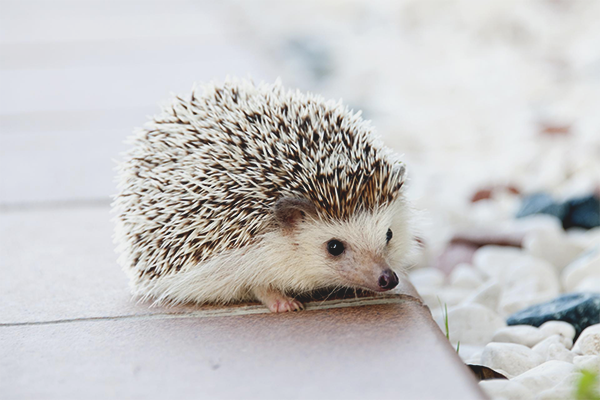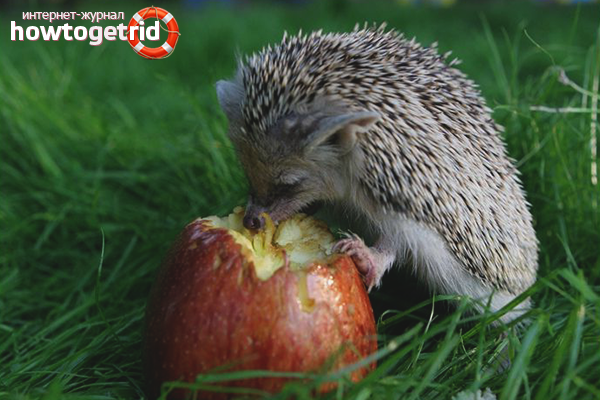The content of the article
The hedgehog is an omnivorous mammal that belongs to the hedgehog family. The natural habitat of these animals are forests, glades, floodplains of rivers, plains. In Eurasia, hedgehogs are common almost everywhere, but in some regions are listed in the Red Book as an endangered species.
Life in the wild
The breeder must understand that the most important thing in caring for a pet is to recreate the conditions of its natural habitat as much as possible. How do hedgehogs live in the wild?
Nutrition
The hedgehogs are a family of omnivores. The opinion that these animals eat only mushrooms and fruits is a myth. In fact, hedgehogs eat arthropods and rodents. In addition, the animal needs fruits and berries.
In conditions of prolonged starvation, hedgehogs are able to eat earthworms and even snakes, including poisonous ones. However, such a diet for the animal will not be useful.
Lifestyle
Hedgehogs live in shallow minks, which in the cold season are hermetically sealed. They hibernate when the ambient temperature drops below 15 ° C. When this is the heart rate of a mammal is reduced to 20 beats per minute, and the frequency of respiratory movements - to one.
Hedgehogs mate in the spring after hibernation. In the litter, the female can have up to 8 calves, the pregnancy lasts 40-49 days. Life expectancy in the wild rarely exceeds 5 years.
How to choose a hedgehog
Before buying a hedgehog, you should carefully examine it. The animal must be mobile, its skin and needles look healthy, and there should be no crusts or mucus on the eyes.The first manifestation of many diseases in hedgehogs is the excessive loss of needles and soured eyes. The most sensible solution is to consult with a veterinarian before purchasing.
Hedgehog adaptation
Hedgehogs get used to the area in which they live, strongly enough. When a pet is bought and transported to a new place, it is under stress. This is due to the fact that hedgehogs have poor eyesight, but excellent sense of smell and hearing. In a new house with unfamiliar smells, the animal will feel in constant danger until it gets used to its surroundings. How to facilitate the adaptation process? There are a few simple tricks:
- Often take a hedgehog in your hands. It cannot be said that these animals need constant company, but the pet needs to get used to the new owner.
- Feed the animal with hands. This is the best way to win over any animal. Show that you are friendly.
- Eliminate the influence of strong flavors. Should be removed from the room where there is a cage with a hedgehog, air fresheners, perfumes, cigarettes and other sources of smell.
- Put your unwashed clothes near the cage. Hedgehog quickly get used to the owner, if you constantly feel his presence.
- Do not place the animal in a noisy room, it will only increase stress.
Cell selection
Hedgehogs are very mobile animals, they love to run, because the cage must be big enough. It is important that it is securely closed, because these pets are real masters of escape. You can not select bunk cells. Pets have poor eyesight, and it is difficult for them to climb to the second floor. In addition, the bones of hedgehogs are fragile, clambering and entangling in the rods, the pet can damage the foot.
In the cage there must be a litter, it should be made from natural materials: wooden sawdust or grass. Hedgehogs love to hide, they definitely need a mink. Replace it at home can a small but closed house. Another essential component is the running wheel, otherwise the hedgehog will suffer from hypodynamia.
You can try to teach a pet to the toilet tray. To do this, it should be filled with materials other than bedding. Suitable for these purposes, the usual cat litter. However, it must be borne in mind that hedgehogs are not easily amenable to such training and defend their needs where they want.
Nutrition
The most common disease of hedgehogs in captivity is obesity. It becomes the cause of their premature death, because it is necessary to maximally balance the pet's diet.
In pet stores you can buy special food for hedgehogs. In case of its absence, dry food for cats is suitable, the taste preferences of animals are in many ways similar. In addition, the hedgehog should be fed with meat, fish, eggs and fruit.
Low-fat boiled chicken or fish, boiled eggs, non-acidic apples, ready-made peas are suitable as complementary foods. Food during cooking can not be salted, and you can not give raw meat. There are a number of products that are forbidden to feed hedgehogs, these include: tomatoes, grapes, raisins, milk, avocados, alcohol, sweets, bread.
The pet's manger should be low enough and wide enough for the hedgehog to climb inside. Thus it will be more convenient for him to eat. At the same time, it must be heavy so that the pet could not turn it over.
Some basic rules
- Watch the ambient temperature. By reducing it to 15 ° C, the hedgehog will hibernate. This condition is often perceived by the owners as death, but in fact the pet is alive.Already at 22 ° C, hedgehogs become lethargic, adynamic, there is a risk of developing pneumonia.
- It is impossible to place two males in one cage. These animals have a fierce struggle for territory between the representatives of the stronger sex, they can cripple each other or even kill.
- Always close the cage and check its tightness. A hedgehog will take advantage of any opportunity to escape and may cause many problems due to this.
- Periodically release the animal so that it can run around the room. In the wild, hedgehogs have a fairly large area.
- Feed your pet in the evening, because its activity increases at night and energy is needed at this particular time.
- Needle prolapse is a normal process, however, if the needles do not grow back and the bald areas remain, contact your veterinarian.
With proper care, the life time of a hedgehog in captivity can reach 12 years. It is necessary to adhere to the basic rules, and the pet for a long time will delight you with its presence.
Video: how to care for hedgehogs






 2 votes, on average: 3,50 out of 5
2 votes, on average: 3,50 out of 5







To send